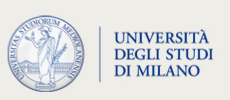Copyright
The contents of the copyright section have been edited by Paola Galimberti.
indice paragrafi
- Relevant legislation
- What is copyright protection?
- What cannot be protected by copyright?
- Who is the author?
- What are the rights?
- How long do the rights last?
- How are rights transmitted?
- Exceptions and limitations
- Can photocopies be made?
- Can I photocopy the texts from the library?
Relevant legislation
In terms of copyright protection, the legislative framework of reference primarily consists of the Berne Convention of 1886, which has been revised several times, most recently in 1971, and which contains general provisions; of numerous European Community Directives that seek to harmonize the national laws of the member countries; in the case of Italy, it consists of law no. 633 dated 22 April 1941, as amended, and book V title IX art. 2575-2583 of the Civil Code.
In particular, DDL S1861 states that the publication of low-resolution images or music on Internet is free as long as they are downgraded.
What is copyright protection?
The copyright law protects intellectual works that are creative, that is to say, with elements of novelty and originality.
Protection concerns the form that the work assumes, not the ideas contained in it, which are instead the patrimony of all.
As an example (although not complete) the copyright law protects the following:
- literary, dramatic, scientific, didactic, religious works;
- musical works and compositions, with or without words;
- works of choreography or pantomime, the outlines of which are fixed in writing or otherwise;
- works of sculpture, painting, drawing, engraving and similar figurative art, including scenography;
- drawings and works of architecture;
- works of cinematographic art, silent or with sound;
- photographic works and those expressed with a procedure similar to that of photography;
- processing programs.
What cannot be protected by copyright?
Works in the public domain are not protected by copyright, i.e. works for which the copyright protection has expired or cannot be exercised (this is the case of laws, regulations, ordinances, circulars, decrees issued by the national government, regions, local authorities and, in general, by public administrations).
Who is the author?
The ownership of the work can be attributed to one or more subjects, depending on whether the work was created by a single subject or by several subjects working together. Authorship is acquired with the creation of the work in any form.
What are the rights?
- Moral rights: these rights are essential, cannot be transferred to third parties (but can be claimed by the heirs), and do not have an expiry date.They include: authorship, integrity, right of unpublished works, right to withdraw the work from commerce
- Rights of economic use: these rights can be transferred by the author to third parties (typically a publisher) and the assignment can be exclusive (to a single subject ) or non-exclusive (the same rights to different subjects). They include, among others: publication, communication, reproduction, distribution, communication to the public, loan and rental, translation, etc.
- Related rights: these are rights of economic exploitation related to some genres or particular works. Holders of these rights are, among others: the photographer of simple photographs, the creator of the database, the actors, interpreters and performers. In particular, for critical and scientific editions, the editor is entitled to exclusive rights of economic use for expert commentary. The duration of these rights is 20 years from the date of publication.
How long do the rights last?
The duration of the economic rights (the moral rights do not expire) is for 70 years after the death of the author. After 70 years the work becomes public domain. If a public domain work is published by an editor, the rights for that work expire after 25 years. The rights on simple photographs expire 20 years after their production.
How are rights transmitted?
The copyrights may be transmitted or acquired in various ways, but in the event of a dispute they must be proven in writing.
Exceptions and limitations
These are exceptions to the rights of economic use in order to protect the interests of the community, such as the promotion of culture, public information, free discussion, study and research.
These can be:
for the benefit of education, discussion, criticism, teaching, scientific research, public information;
they may concern personal use (in particular the right to make photocopies within the limit of 15%, see below) or provisions in favour of the disabled.
For these uses, the author’s consent is not necessary; however, they are not necessarily free.
Can photocopies be made?
To photocopy means to reproduce a work, performed by any means, both analogue and digital. Although reproduction is one of the rights of economic use held exclusively by the author, in some cases it may take place freely:
- Reproduction for personal use, by hand or by means not suitable for dissemination, is always legal.
- Reproduction for personal use by means suitable for dissemination is permitted within the limits of 15% of each volume or an issue of a periodical. The reproduction of musical scores is forbidden.
As regards works in the public domain, the general rule is that they can be photocopied in full unless:
- it is a work that has been translated from another language (the rights expire 70 years after the translator's death)
- it is a critical edition or scientific commentary (the rights expire 20 years after the curator's death).
Can I photocopy the texts from the library?
The texts owned by the libraries may be photocopied for personal use only, and ONLY within the limit of 15%.
If the book owned by the library is not found in the editorial catalogues or is difficult to find on the market, it can be photocopied integrally if you do it inside the public library and if you do it for personal use.


